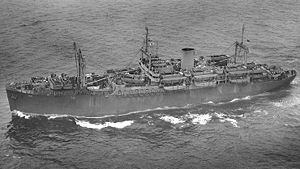Frederick Funston class attack transport
| |
This article does not cite any references or sources. Please help improve this article by adding citations to reliable sources. Unsourced material may be challenged and removed. (March 2009) |
 USS James O'Hara (APA-90), a ship of the Frederick Funston class, at Hampton Roads, 23 August 1943 | |
| Class overview | |
|---|---|
| Name: | Frederick Funston class |
| Builders: | Gulf Shipbuilding |
| Operators: | |
| Preceded by: | Arthur Middleton class |
| Succeeded by: | Doyen class |
| In commission: | 24 Apr 1943 - 26 Apr 1943 - Probably around 1960 |
| Completed: | 2 |
| General characteristics | |
| Type: | Attack transport |
| Displacement: | 7,000-8,600 tons (lt) |
| Length: | 492 ft 8 in (150.16 m) |
| Beam: | 69 ft 6 in (21.18 m) |
| Draft: | 26 ft 6 in (8.08 m) (limiting) |
| Propulsion: | Geared Turbine Drive, designed shaft horsepower 8,000-8,500 |
| Speed: | 16.5 knots (30.6 km/h) |
| Capacity: | Troops: 2,200 |
| Complement: | 519-576 |
| Armament: | 1 x 5"/38 caliber dual-purpose gun, 2 x 3"/50 caliber dp guns, 8 x 1.1" AA guns, replaced by 16 x 20mm gun mounts |
The Frederick Funston-class attack transport was a class of US Navy attack transports. They saw service in World War II and later in the Korean War.
Attack transports were a special type of transport ship designed to transport troops and their equipment over long distances to hostile shores, and then execute an amphibious invasion at the destination, using an array of smaller integral assault boats. Like all attack transports, the Frederick Funston-class was generously armed with antiaircraft weaponry to protect itself and its vulnerable cargo of troops from air attack in the battle zone.
History
The class derives its name from US Army General Frederick Funston, a veteran of the Philippine-American War and Medal of Honor recipient. The two ships of the Frederick Funston class were based on the Maritime Commission's ubiquitous Type C3 hull (specifically Type C3-S-A1). They began their service lives as transport ships for the US Army, but after several months of service in this role they were acquired by the US Navy and reclassified attack transports. It is not known whether they underwent any modifications for their new role.
The Funstons are somewhat unusual in that unlike most other classes of APA, they appear to have had little or no space devoted to cargo. This apparent shortcoming did however enable them to carry a larger number of troops - 2,200 as opposed to the 1,200 to 1,500 of most other APA's.
In service
The Frederick Funstons participated in the Mediterranean Theatre, taking part in the invasions of Salerno and Italy, and later in the Pacific Theatre. After the war, they were decommissioned and returned to the US Army, when they were redesignated USAT (US Army Transport). In the 1950s the ships were reacquired by the Navy and reclassified T-AP. Both of them then went on to serve in the Korean War - mostly it appears on transport missions[vague].
Both ships were probably struck from the Naval Register in about 1960, and were scrapped in 1968-69.
References
See the DANFS entries for the individual ships: USS Frederick Funston (APA-89) and USS James O'Hara (APA-90).
| ||||||||
- Articles lacking sources from March 2009
- Articles with invalid date parameter in template
- All articles lacking sources
- All Wikipedia articles needing clarification
- Wikipedia articles needing clarification from March 2009
- Frederick Funston class attack transports
- World War II amphibious warfare vessels of the United States
